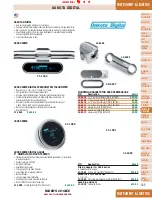
NovaLynx Corporation________________________________________________________________________________
200-WS-04
Page 5
April 2021
4
SPECIFICATIONS
5
SITE SELECTION
WARNING: Avoid overhead power lines whenever possible. If there are overhead power lines, use
extreme care to prevent contact with the power lines while installing the equipment.
Choose a mounting location for the wind sensor that is free of obstructions since nearby objects can
create eddy currents that will affect the wind measurements. Try to locate the wind sensor so that the
nearest object is 10 x T away from the wind sensor mast, where T is the height of the object.
Roof mounted sensors should be placed on the upwind side of the building and away from all exhaust
vents. If the sensor is located on top of a building the sensor height should be 1.5 x H, where H is the
height of the building.
In all cases when the wind sensor data is to be correlated to National Weather Service data or World
Meteorological Organization data, the standard exposure is 33 feet (10 meters) above the ground.
Birds of all sizes find the shaft of the wind vane a desirable place to land. The weight of a large bird can
easily damage the potentiometer by breaking it loose from the body of the sensor. The best way to
reduce this hazard is to provide an alternate landing site nearby that would be more attractive to the
weary bird.
Measurement Range
0-360 degree azimuth
Potentiometer Gap
5 degree (approximate)
Accuracy
±3 degrees
Vane Threshold
1.2 mph (0.5364 m/s)
Distance Constant
1.5 feet (45.72 cm)
Time Constant
2 seconds
Damping Ratio
0.4
Transducer Type
20k ohm, 20% tolerance, 1% linearity, bushing type bearing
Maximum Rating
1/4 watt
Turning Radius
10.5 inch (26.67 cm)
Cable
40 feet (12 m), 3 conductor, 24 AWG, shielded, tinned leads
Mounting
1.07 inch diameter by 0.82 inch socket (27 mm dia x 21 mm)
(fits standard 3/4" IPS pipe)
Assembled Dimensions
11.4" H x 15.2" W x 1.6" D (29 x 39 x 4 cm)
Weight / Shipping
1.65 lbs (0.75 kg) / 2 lbs (0.9 kg)
200-WS-04 Wind Vane Specification




























